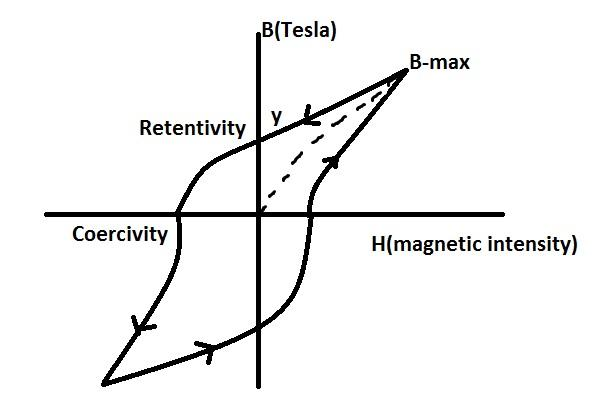
Draw hysteresis curve (B-H curve) for a ferromagnetic substance.
Answer
547.2k+ views
Hint: Hysteresis is characterized as a lag of magnetization intensity ($B$) behind the magnetic field intensity ($H$). For a ferromagnetic substance, When ferromagnetic materials are placed inside a current-carrying coil the magnetizing field $H$ caused by the current forces some or all the atomic magnetic dipoles in the material to align with the external magnetizing field, in this way material gets magnetized.
Complete Step by Step Solution: Hysteresis occurs in a system that involves a magnetic field. Hysteresis is the common property of ferromagnetic substances. Generally, when the magnetization of ferromagnetic materials lags behind the magnetic field this effect can be described as the hysteresis effect. It relates to the magnetisation properties of a material by which it firstly becomes magnetised and then demagnetised.
The meaning of hysteresis is “lagging”.
All ferromagnetic materials exhibit the phenomena of hysteresis.

The Magnetic Hysteresis loop above, shows the behaviour of a ferromagnetic core graphically as the relationship between $B$ and $H$ is non-linear.
Starting with an unmagnetized core both $B$ and $H$ will be at zero, point 0 on the magnetisation curve. The $B - H$ curve follows the path as shown, as the magnetising current flowing through the coil alternates between a positive and negative value such as the cycle of an AC voltage. This path is called a Magnetic Hysteresis Loop.
Note: The effect of magnetic hysteresis shows that the magnetisation process of a ferromagnetic core and therefore the flux density depends on which part of the curve the ferromagnetic core is magnetised on as this depends upon the circuits past history giving the core a form of “memory”. Then ferromagnetic materials have memory because they remain magnetised after the external magnetic field has been removed.
However, soft ferromagnetic materials such as iron or silicon steel have very narrow magnetic hysteresis loops resulting in very small amounts of residual magnetism making them ideal for use in relays, solenoids and transformers as they can be easily magnetised and demagnetised.
Complete Step by Step Solution: Hysteresis occurs in a system that involves a magnetic field. Hysteresis is the common property of ferromagnetic substances. Generally, when the magnetization of ferromagnetic materials lags behind the magnetic field this effect can be described as the hysteresis effect. It relates to the magnetisation properties of a material by which it firstly becomes magnetised and then demagnetised.
The meaning of hysteresis is “lagging”.
All ferromagnetic materials exhibit the phenomena of hysteresis.

The Magnetic Hysteresis loop above, shows the behaviour of a ferromagnetic core graphically as the relationship between $B$ and $H$ is non-linear.
Starting with an unmagnetized core both $B$ and $H$ will be at zero, point 0 on the magnetisation curve. The $B - H$ curve follows the path as shown, as the magnetising current flowing through the coil alternates between a positive and negative value such as the cycle of an AC voltage. This path is called a Magnetic Hysteresis Loop.
Note: The effect of magnetic hysteresis shows that the magnetisation process of a ferromagnetic core and therefore the flux density depends on which part of the curve the ferromagnetic core is magnetised on as this depends upon the circuits past history giving the core a form of “memory”. Then ferromagnetic materials have memory because they remain magnetised after the external magnetic field has been removed.
However, soft ferromagnetic materials such as iron or silicon steel have very narrow magnetic hysteresis loops resulting in very small amounts of residual magnetism making them ideal for use in relays, solenoids and transformers as they can be easily magnetised and demagnetised.
Recently Updated Pages
A man running at a speed 5 ms is viewed in the side class 12 physics CBSE

The number of solutions in x in 02pi for which sqrt class 12 maths CBSE

State and explain Hardy Weinbergs Principle class 12 biology CBSE

Write any two methods of preparation of phenol Give class 12 chemistry CBSE

Which of the following statements is wrong a Amnion class 12 biology CBSE

Differentiate between action potential and resting class 12 biology CBSE

Trending doubts
What are the major means of transport Explain each class 12 social science CBSE

Which are the Top 10 Largest Countries of the World?

Draw a labelled sketch of the human eye class 12 physics CBSE

Explain sex determination in humans with line diag class 12 biology CBSE

Explain sex determination in humans with the help of class 12 biology CBSE

Differentiate between homogeneous and heterogeneous class 12 chemistry CBSE




